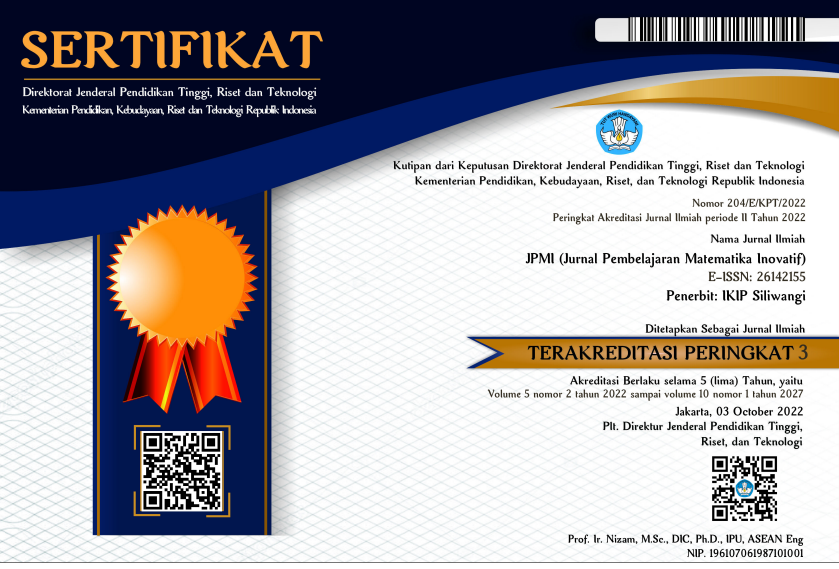PENGEMBANGAN PERANGKAT PEMBELAJARAN BERBASIS PROBLEM POSING UNTUK MELATIH KREATIVITAS DALAM PEMECAHAN MASALAH
Keywords:
Learning Tools, Problem Posing, Problem Solving CreativityAbstract
Creativity is very important in today's modern era so it must be increased by making efforts such as creating learning tools to train students' creativity to raise their problems while solving those problems. The purpose of this study is (1) to describe the quality of learning by using the problem-posing approach to train students' creativity in problem solving; (2) to describe the creativity of students in solving problems in the perimetri and area of rectangle based on problem-posing. This research is a development research. Data collection techniques using questionnaires, tests, observations, and validation methods. The results showed that (1) The problem-posing approach has the quality to increase the creativity of students in solving problems of perimetri and area of rectangle; (2) After learning with problem posing showed that the students' creativity test results increased from the previous test.
References
Ayllon, M., Gomez, I., & Ballesta-Claver, J. (2016). Mathematical thinking and creativity through mathematical problem posing and solving. Propósitos y Representaciones, 4(1), 169–218. https://doi.org/http://dx.doi.org/10.20511/ pyr2016.v4n1.89
Bedir, H. (2019). Pre-service ELT teachers’ beliefs and perceptions on 21st century learning and innovation skills (4Cs). Journal of Language and Linguistic Studies, 15(1), 231–246. https://doi.org/10.17263/jlls.547718
Bonotto, C. (2013). Artifacts as sources for problem-posing activities. Educational Studies in Mathematics, 83(1), 37–55. https://doi.org/10.1007/s10649-012-9441-7
Gunawan, & , Hairunnisyah Sahidu, Ahmad Harjono, and N. M. Y. S. (2017). THE EFFECT OF PROJECT BASED LEARNING WITH VIRTUAL MEDIA ASSISTANCE ON STUDENT’S CREATIVITY IN PHYSICS. Cakrawala Pendidikan, 167–179.
Lawhon, D. (1976). Instructional development for training teachers of exceptional children: A sourcebook. Journal of School Psychology, 14(1), 75. https://doi.org/10.1016/0022-4405(76)90066-2
MÃnguez, R., & Jesus, F. Del. (2015). Revisited mixed extreme wave climate model for reanalysis data bases. In Stochastic Environmental Research and Risk Assessment (Vol. 29, Issue 7). https://doi.org/10.1007/s00477-014-0937-9
Nieven, N., Akker, J. V., Branch, R. M., Gustafson, K., & Plomp, T. (1999). Design Approaches and Tools in Education and Training. New York: Kluwer Academic Publisher.
Nuha, M. A., Waluya, S. B., & Junaedi, I. (2018). Mathematical creative process wallas model in students problem posing with lesson study approach. International Journal of Instruction, 11(2), 527–538. https://doi.org/10.12973/iji.2018.11236a
Ozdemir, A. S., & Sahal, M. (2018). The effect of teaching integers through the problem posing approach on students’ academic achievement and mathematics attitudes. Eurasian Journal of Educational
Research, 2018(78), 117–138. https://doi.org/10.14689/ejer.2018.78.6
Özgenel, M. (2018). Modeling the relationships between school administrators’ creative and critical thinking dispositions with decision making styles and problem solving skills. Kuram ve Uygulamada Egitim
Bilimleri, 18(3), 673–700. https://doi.org/10.12738/estp.2018.3.0068
Pelczer, Ildiko, & Rodriguez, F. G. (n.d.). Creativity assessment in school settings through problem posing tasks. 8, 383–398.
Pelczer, Ildikó, & RodrÃguez, F. G. (2011). Pelczer Rodriguez. The Montana Mathematiics Enthusiast, 8(ISSN 1551-3440), 383–398.
Rahardjanto, A., Husamah, & Fauzi, A. (2019). Hybrid-PjBL: Learning outcomes, creative thinking skills, and learning motivation of preservice teacher. International Journal of Instruction, 12(2), 179–192. https://doi.org/10.29333/iji.2019.12212a
Robson, A. (1945). Reviewed Work: How to Solve It by G. Pólya. In The Mathematical Gazette (Vol. 30, p. 181). https://doi.org/10.2307/3609122
Silver, E.A.; Cai, J. (2005). Assessing students’ mathematical problem posing, Teaching Children Mathematics. : : Https://Www.Researchgate.Net/Publication/258510514 Silver, 129–135.
Silver, E. A. (1997). Fostering creativity through instruction rich in mathematical problem solving and problem posing. ZDM - International Journal on Mathematics Education, 29(3), 75–80. https://doi.org/10.1007/s11858-997-0003-x
Siswono, T. Y. (2018). Pembelajaran Matematika Berbasis Pengajuan dan Pemecahan Masalah. Bandung: PT. Remaja Rosdakarya.
Suarsana, I. M., Lestari, I. A. P. D., & Mertasari, N. M. S. (2019). The effect of online problem posing on students’ problem-solving abilitiy in mathematics. International Journal of Instruction, 12(1), 809–820. https://doi.org/10.29333/iji.2019.12152a
Riduwan, & Sunarto. (2014). Pengantar Statistik: Untuk Penelitian Pendidikan, Sosial, Ekonomi, Komunikasi, dan Bisnis. Bandung: Alfabeta.
Thiagarajan, S., Semmel, D. S., & Semmel, M. I. (1974). Instructional Development for Training Teachers of Exceptional Children: A Sourcebook. Minneapolis: Indiana University.
Trianto. (2010). Pengembangan Model Pembelajaran Tematik. Jakarta: Prestasi Pustaka.
Van Harpen, X. Y., & Sriraman, B. (2013). Creativity and mathematical problem posing: An analysis of high school students’ mathematical problem posing in China and the USA. Educational Studies in Mathematics, 82(2), 201–221. https://doi.org/10.1007/s10649-012-9419-5

















